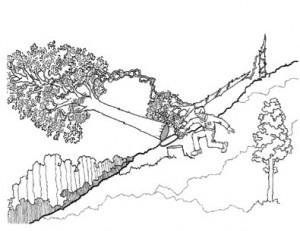BACKGROUND: A logger was felling his last tree of the day on his way back to the landing site. He was working on a summer afternoon in the Appalachians on a steep slope that was rocky and laden with grapevines.
PERSONAL CHARACTERISTICS: The 36-year-old tree feller had been employed in logging for 15 years. His employer had no written safety program, but the tree feller had attended a chain saw safety workshop 5 years earlier. The employer had issued hard hats, chaps, safety glasses, and hearing protection to fellers, but it was reported that this tree feller was not wearing any of his personal protective equipment.
UNSAFE ACTS AND CONDITIONS: The feller began cutting a 30-inch-diameter poplar on a very steep slope. Eighteen feet directly behind and uphill from the feller was a small tree (approximately six-inch dbh) with grapevines entangled in its top, connecting it to the large poplar being felled. Without clearing an adequate escape path, the timber feller severed the poplar and moved four feet from the stump.
ACCIDENT: As the poplar fell, the grapevine pulled on the small tree, breaking it off at a point nine feet above the ground. The falling poplar and grapevine continued pulling the broken portion of the smaller tree downhill until it struck the feller on the back of the head.
INJURY: Co-workers (who had finished for the day and were on their way to the landing) heard the tree fall and yelled to the feller, but they received no response. One worker found the immobile feller; he then ran to the landing and used the cellular phone to summon medical help. Other crew members administered first aid and CPR. The Emergency Medical Technician arrived in approximately 25 minutes, and the feller was transported to the local trauma center, where he died two hours later.
RECOMMENDATIONS FOR CORRECTION:
- Properly evaluate the area around timber to be felled so that potential hazards can be identified. Cut grapevines, and remove danger trees using mechanical or other techniques that minimize the loggers’ exposure before felling begins in the area.
- Prepare an adequate escape path, and move a safe distance diagonally away from the base of the tree as it is falling.
- Develop, implement, and enforce a written safety program that includes training in hazard identification, avoidance, and abatement. Enforce a policy requiring the use of personal protective equipment.
 Courtesy of the Forest Resources Association: https://www.forestresources.org/
Courtesy of the Forest Resources Association: https://www.forestresources.org/
